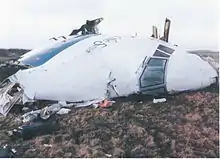Lockerbie
Lockerbie (/ˈlɒkərbi/, Scottish Gaelic: Locarbaidh[2]) is a small town in Dumfries and Galloway, south-western Scotland. It lies approximately 120 kilometres (75 miles) from Glasgow, and 25 km (16 mi) from the border with England. It had a population of 4,009 at the 2001 census. The town came to international attention in December 1988 when the wreckage of Pan Am Flight 103 crashed there following a terrorist bomb attack aboard the flight.
Lockerbie
| |
|---|---|
 East Lockerbie in December 2009 | |
 Lockerbie Location within Dumfries and Galloway | |
| Population | 4,240 (mid-2016 est.)[1] |
| OS grid reference | NY135815 |
| • Edinburgh | 58 mi (93 km) |
| • London | 283 mi (455 km) |
| Community council |
|
| Council area | |
| Lieutenancy area | |
| Country | Scotland |
| Sovereign state | United Kingdom |
| Post town | LOCKERBIE |
| Postcode district | DG11 |
| Dialling code | 01576 |
| Police | Scotland |
| Fire | Scottish |
| Ambulance | Scottish |
| UK Parliament | |
| Scottish Parliament | |
History
Lockerbie has existed since at least the days of Viking influence in this part of Scotland in the period around 900. The name (originally "Loc-hard's by") means Lockard Town in Old Norse. The presence of the remains of a Roman camp 1 mi (2 km) to the west of the town suggests its origins may be even earlier. Lockerbie first entered recorded history in the 1190s in a charter of Robert de Brus, 2nd Lord of Annandale, granting the lands of Lockerbie to Adam de Carlyle.[3] It appears as Lokardebi in 1306.[4]
About 2 mi (3 km) to the west of Lockerbie on 7 December 1593, Clan Johnstone fought Clan Maxwell at the Battle of Dryfe Sands. The Johnstones nearly exterminated the Maxwells involved in the battle, leading to the expression "Lockerbie Lick."[5]
Lockerbie's main period of growth started in 1730 when the landowners, the Johnstone family, made plots of land available along the line of the High Street, producing in effect a semi-planned settlement. By 1750 Lockerbie had become a significant town, and from the 1780s it was a staging post on the carriage route from Glasgow to London.
Perhaps the most important period of growth was during the 19th century. Thomas Telford's Carlisle-to-Glasgow road was built through Lockerbie from 1816. The Caledonian Railway opened the line from Carlisle to Beattock through Lockerbie in 1847 and later all the way to Glasgow. From 1863 until 1966 Lockerbie was also a railway junction, serving a branch line to Dumfries. Known as the Dumfries, Lochmaben and Lockerbie Railway, it was closed to passengers in 1952 and to freight in 1966. The town is served by Lockerbie railway station.
Lockerbie had been home to Scotland's largest lamb market since the 18th century but the arrival of the Caledonian Railway increased further its role in the cross-border trade in sheep. The railway also produced a lowering in the price of coal, allowing a gas works to be built in the town in 1855.

Hallmuir Prisoner of War Camp
About 1.5 miles (2.4 km) south of Lockerbie along the C92 road to Dalton are the remains of Hallmuir prisoner-of-war camp.[6] After the Second World War, this camp housed Ukrainian soldiers from the Galician Division of the Waffen SS. They built a chapel from converted army huts. It was listed in 2003 as a Category B building.[7] The chapel remains in use, currently holding Ukrainian services on the first Sunday of every alternate month.
Pan American 103 bombing

Lockerbie is known internationally as the place where, on 21 December 1988, the wreckage of Pan Am Flight 103 crashed after a terrorist bomb on board detonated. In the United Kingdom, the event is often referred to as the "Lockerbie disaster" or the "Lockerbie bombing". Eleven residents of the town were killed in Sherwood Crescent, where the aircraft's wings and fuel tanks plummeted in a fiery explosion, destroying several houses and leaving a large crater, with debris causing damage to other buildings nearby. All 259 people on the flight also died. The 270 total victims were citizens of 20 different nations. The event remains the deadliest terrorist attack and aviation disaster in Britain.
Lockerbie Academy, the town's high school, became the headquarters for the response and recovery effort after the Pan Am Flight 103 disaster. Subsequently, the academy, in cooperation with Syracuse University of Syracuse, New York, US, which lost 35 students in the bombing, established a scholarship at the university. Each year, two students spend one academic year at Syracuse University as Lockerbie Scholars before they begin their university study. The rector of Lockerbie Academy, Graham Herbert, was recognised in November 2003 at Syracuse University with the Chancellor's Medal for outstanding service. A former student of the Academy, Helen Jones, was killed in the 7 July 2005 London bombings. In her memory, a new scholarship was set up, awarding £1000 towards further education to aspiring accounting students from the Academy.[8]
Notable buildings, architecture and people
Much of Lockerbie is built from red sandstone. There are several imposing buildings near the centre, including the Town Hall, completed in 1880, with its clock tower.
A little to the north of the centre is the Dryfesdale Parish Church, with its brightly decorated interior. The name Dryfesdale comes from the local river, the Dryfe Water, which joins the River Annan a little to the west of the town. In 1887 local architect F.J.C. Caruthers was commissioned to work on the Town Hall steeple. His design was a mixture of Jacobean and Baronial, and included a cupola which was not favourably received.[9]
Dryfesdale Lodge Visitors' Centre,[10] formerly a cemetery worker's cottage, was opened on 25 October 2003 after extensive renovation work funded by the Lockerbie Trust and is maintained with grant assistance from Dumfries & Galloway Council. There are two exhibition rooms in the Lodge and also the Dryfesdale Room that is used as a quiet room for visitors to reflect. A permanent exhibition room displays ten history panels depicting Lockerbie's past, stretching from its prehistoric origins to 1988's terrorist attack and beyond. In the cemetery grounds nearby is the Lockerbie Memorial Garden of Remembrance.

Lockerbie House was built in 1814 for Sir William Douglas, 4th Baronet of Kelhead and Dame Grace Johnstone and their children: Mary, Catherine, Christian, Henry Alexander, William Robert Keith Douglas, Charles Douglas, 6th Marquess of Queensberry and John Douglas, 7th Marquess of Queensberry. It was inhabited by several different members of the Douglas family through the generations; including both Archibald Douglas, 8th Marquis of Queensberry PC (son of John Douglas) and his wife Caroline Margaret Clayton (daughter of General Sir William Robert Clayton MP) and their children British mountaineer Lord Francis William Bouverie Douglas, Lady Gertrude Georgiana Douglas, John Sholto Douglas, Viscount Drumlanrig and later the 9th Marquess of Queensberry, clergyman Lord Archibald Edward Douglas and the twins Lord James Douglas and Lady Florence Dixie (who married Sir Alexander Beaumont Churchill Dixie, 11th Baronet). John Sholto Douglas was a patron of sport and a noted boxing enthusiast. In 1866 he was one of the founders of the Amateur Athletic Club, now the Amateur Athletic Association of England. The following year the club published a set of twelve rules for conducting boxing matches. The rules had been drawn up by John Graham Chambers, but appeared under Queensberry's sponsorship and are universally known as the "Marquess of Queensberry rules".
Lockerbie House is an important establishment within Lockerbie, in the past having been owned mainly by the Johnstone Baronets and Douglas family together with most of the land and housing within the town. Like much of Lockerbie, this Georgian house is built of old red sandstone. It has about 40 bedrooms, and is situated within 78 acres (32 hectares) of secluded woodland and gardens, with several outbuildings including a gatehouse, a 2-acre (0.8 ha) walled garden, croquet lawn, orchards, helipad and a hunting dog pen. Until recently there was also a large stable block, but that has been partly converted into a house; the remaining stables are used by a local riding school. This large property has frequently been used as a country house hotel. The house is now owned by outdoor pursuits company Manor Adventure, and serves as a centre for school activity courses and family adventure holidays.[11]
Steven's Croft power station opened in 2008 just to the north of the town. It is the largest biomass-powered electric generator in the UK.[12]
Sport
Located across the road from Lockerbie Academy, Lockerbie Ice Rink was built in 1966 and is one of the oldest indoor ice rinks in the United Kingdom. In curling it has given rise to World and European Champions and Olympians in the adult, senior and junior disciplines.
The town's senior football club is Mid-Annandale, who compete in the South of Scotland Football League. The club play at the recently refurbished King Edward Park.
Cultural references
Falling: a wake - A play by Gary Kirkham
Based on a true story. Harold and Elsie live quietly on an isolated farm. When a commercial jetliner explodes high above their land scattering wreckage and debris across the region, their lives are forever changed.
The Lockerbie women - A play by Deborah Brevoort
This play is based on the Women of Lockerbie. One woman, whose son died in the bombing of the plane, discovers a group of women who are trying to collect the victims' clothing, which had been scattered across Lockerbie.
See also
References
- "Mid-2016 Population Estimates for Settlements and Localities in Scotland". National Records of Scotland. 12 March 2018. Retrieved 30 December 2020.
- "Ainmean-Àite na h-Alba". Archived from the original on 26 March 2017. Retrieved 13 November 2011.
- "Document 3/106/9 (Annandale, no. 2 )", People of Medieval Scotland website.
- "Lockerbie", Undiscovered Scotland. Retrieved 11 August 2016.
- "Battle of Dryfe Sands" (PDF). Archived from the original (PDF) on 15 May 2011. Retrieved 25 July 2012.
- "Description of Hallmuir POW camp". Allaboutlockerbie.com. Retrieved 16 May 2011.
- Historic Environment Scotland. "Hallmuir, Ukranian [sic] Chapel (Greek Catholic) with Memorial (LB49592)". Retrieved 18 April 2019.
- Deborah Haynes and David Robertson 1. "Helen Jones' scholarship". The Times. UK. Archived from the original on 13 January 2008. Retrieved 16 May 2011.
- Gifford, John, 1946-2013. (1996). Dumfries and Galloway. Buildings of Scotland Trust. London: Penguin Books. p. 77. ISBN 0140710671. OCLC 34612234.CS1 maint: multiple names: authors list (link)
- Dryfesdale Lodge Visitors Centre Trust. "Dryfesdale Lodge Visitors Centre". Dryfesdalelodge.org.uk. Archived from the original on 7 February 2011. Retrieved 16 May 2011.
- "Lockerbie Manor, Dumfries and Galloway Scotland". Lockerbiemanor.co.uk. Retrieved 16 May 2011.
- "Green power station site opened". BBC Online. 19 March 2008. Retrieved 26 March 2017.
External links
| Wikimedia Commons has media related to Lockerbie. |
| Wikisource has the text of the 1911 Encyclopædia Britannica article Lockerbie. |